Lobster Thermidor is a classic French dish that I had not prepared before. Now I regret that, because it is really delicious and I will definitely make it again. As I am somewhat of an ‘adopted Italian’, I don’t tend to combine seafood with cheese. But in this case it definitely works, and the cheese doesn’t overpower the lobster. That is also because a modest amount of cheese is used. The dish was created in Paris in 1891 by the famous chef Auguste Escoffier. It consists of lobster meat served in its shell with a sauce and cheese gratin on top. As often with classic recipes there are some variations, such as using béchamel or cream, parmesan cheese or gruyère, including mushrooms or not, and the herbs and spices included.
The nice thing about this dish is that can be made with a fresh (live) lobster, but also with a frozen lobster that was already boiled before being frozen. With a fresh lobster the result can be better, especially if you cook the tail as shown below rather than boiling it. But with a boiled lobster the result is also excellent, and that may be easier to find than a live lobster. Here is my version of Lobster Thermidor.
Ingredients
Serves 2 as an appetizer
1 lobster
25 grams (2 Tbsp) butter
30 grams (1/4 cup) minced shallot
60 ml (1/4 cup) dry white wine
30 ml (2 Tbsp) cognac
120 ml (1/2 cup) cream
1/4 tsp mustard powder
salt and freshly ground white pepper
1 tsp minced fresh flat leaf parsley
freshly grated parmigiano reggiano
1 egg yolk
Instructions
Cut the lobster in half lengthwise. If you do this with a live lobster, start with the head so you will kill it instantly.
It is very difficult to get the raw tail meat out of the shell, so preheat the oven to 225C/440F…
…and arrange the lobster in an oven dish, flesh side down.
Bake the lobster for 5 minutes, then remove the tails.
The claws need to finish cooking before you can get the meat out of them. You can either do this by returning everything but the tails to the oven for another 7 minutes, or by bringing some water to a boil, turning off the heat, and allowing the claws to steep in the hot water for 5 to 10 minutes, depending on their size. After that, allow the claws to cool in cold water. You can now (also if you are using a boiled lobster) remove the lobster meat from the claws, including the knuckles. Reserve the shells for serving the lobster.
Also reserve the lobster drippings that are left behind in the oven dish.
The tail will still be mostly raw, which is how it should be to get the best possible texture for the tail.
Melt 25 grams of butter in a frying pan.
Add 30 grams of minced shallots.
Cook the shallots over medium-low heat, stirring regularly, until they are soft and slightly golden. They should not become crispy or brown.
Increase the heat to medium-high and deglaze the shallots with 30 ml of cognac.
When the cognac has evaporated, deglaze with 60 ml of white wine.
Add 1/4 teaspoon mustard powder to 120 ml cream.
Stir until there are no more lumps.
Add the mustard-infused cream to the shallots as soon as most of the wine has evaporated.
Add the reserved lobster drippings from the oven dish to the sauce.
Allow the cream to reduce over medium heat, stirring regularly. When the sauce has thickened somewhat, season to taste with salt and freshly ground white pepper.
Turn off the heat, and add an egg yolk. Stir to incorporate the egg yolk. This will thicken the sauce.
Add a bit of freshly grated parmigiano reggiano.
Add a bit of minced parsley.
Stir and the sauce is ready.
Slice the lobster meat (tails, claws, and knuckles) and arrange it in a single layer in the lobster shells.
Spoon the sauce on top of the lobster, making sure to cover all of the lobster meat.
Sprinkle with freshly grated parmigiano reggiano.
Put the lobster under a preheated broiler until the cheese is golden, about 5 minutes. This will also cook the tail meat. It is best to do this step under a very hot broiler (or in a very hot oven) to brown the cheese without overcooking the lobster. Serve at once.
Wine pairing
This is great with a white Burgundy, or another complex and creamy (oaked) Chardonnay or other white such as Encruzado, Viura/Macabeo or Verdicchio.
Flashback
Turbot is one of my favorite kinds of fish. It has a great texture and delicate flavor. In this simple preparation it is served with a mint sauce. Click here for the recipe.










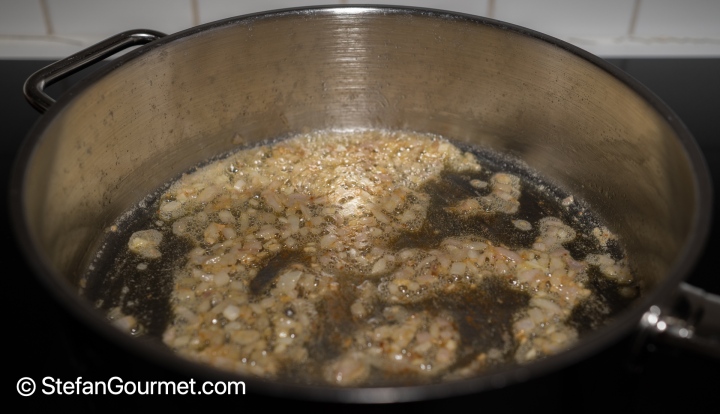

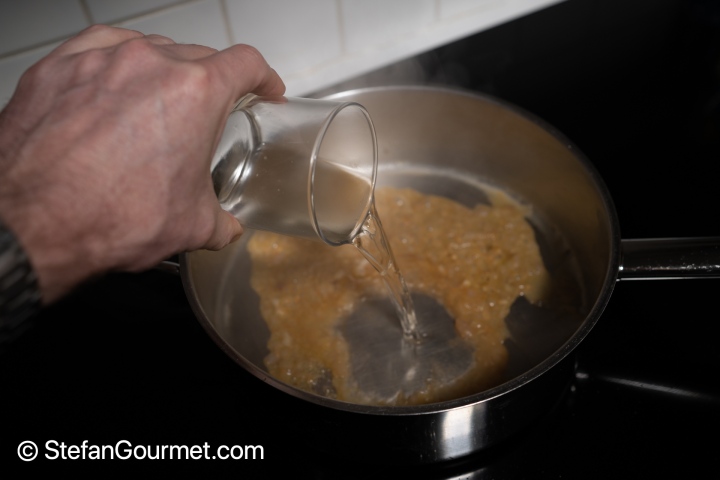

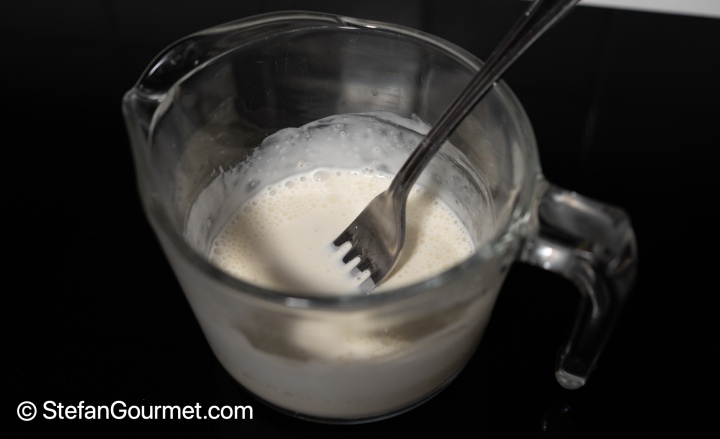








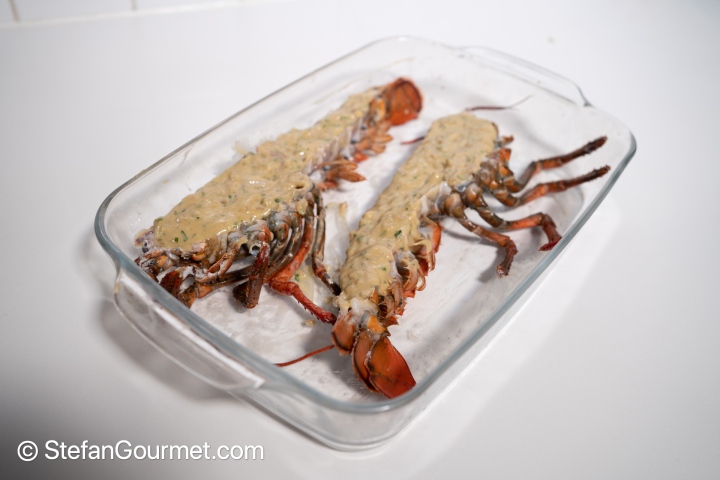
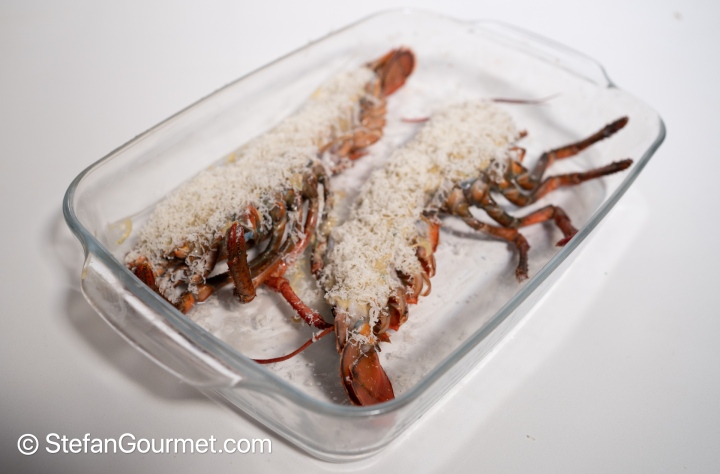



Memories! You’ve brought them back in a very good way. The first lobster that I ever had was lobster thermidor in 1976 at Sabella and La Torre located at Fisherman’s Wharf in San Francisco. They were also famous for their cioppino, a fish stew created by local Italian American fishermen.
LikeLiked by 1 person
What an impressive dish, it will definitely be bookmarked to serve once we are allowed to entertain indoors again.
LikeLiked by 1 person
This is such a special dish, we had it again for Valentine’s day this year. Thank you for sharing the recipe.
LikeLiked by 1 person
Memories – yes, definitely ! Cooked this literally hundreds of times in the 60s and 70s especially for business dinners for overseas visitors. Depending on the size of the beastie, usually the whole lobster and always as a main course . . . sometimes with a small amount of rice under but often just with a green salad . . . yes, usually with one of our fabulous chardonnays ! The only way it was served as first course was as some form of ‘cocktail’ which did not entice. Well, these days they usually cost around 100 dollars each ! This Christmas, during our hectic trade wars with China our supermarkets sold ‘theirs’ to us for Christmas at a flat 20 dollars each and the country forgot its Covid woes and bought them a;most daily at the allowed 4 per person !!!
LikeLiked by 1 person
Awkward trying to do paidwork if one now has lobster dishes on mind – you say this classic is new in your repertoire – obvious question – what about its close cousin Lobster Newburg ? Those two together with Lobster Mornay and Lobster Armoricaine kind’of were the four on every decent restaurant menu ! Oh, with the plain grilled with garlic butter 🙂 ! These days, if the purse allows, it is more steamed with ginger et al Asian style for me . . .
LikeLiked by 1 person
era viva l’aragosta? non posso cucinarla …
LikeLike
Sì era viva. Anche le vongole o i muscoli sono ancora vivi quando li cucini…
LikeLiked by 1 person
lo so … 😦
LikeLike